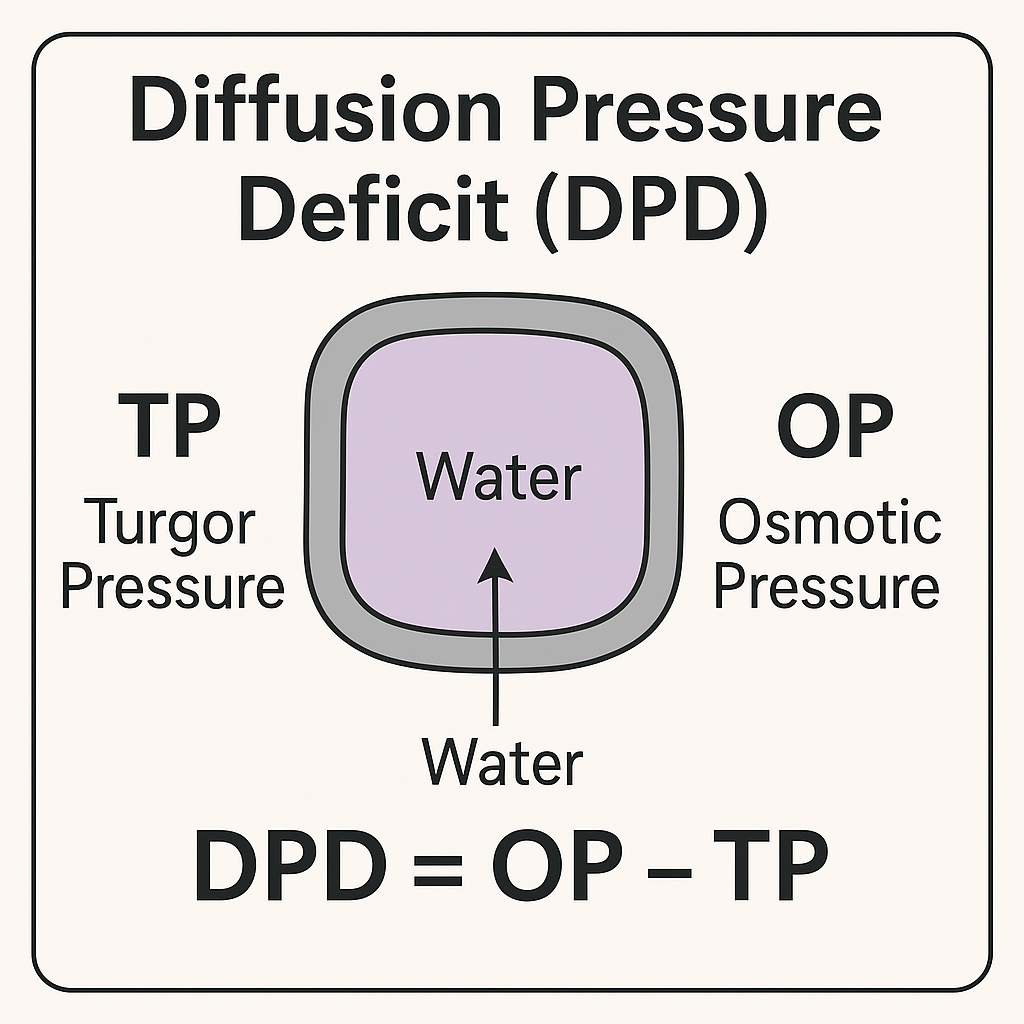🌿 Diffusion Pressure Deficit (DPD)

Learn what Diffusion Pressure Deficit (DPD) is, how it drives water absorption in plants, and why it matters. Includes clear explanations, formulas, examples, and a labelled diagram.
📘 Introduction: Why Do Plants Absorb Water?
Water is life — especially for plants. They don’t just absorb water for drinking; they rely on water to grow, stay upright, make food, and regulate temperature. But how do they know when to absorb water, and what drives this process? What is Diffusion Pressure Deficit (DPD) ?
The answer lies in a concept called Diffusion Pressure Deficit, or simply DPD. Though it sounds complex, it’s one of the most fundamental forces behind how plants manage water intake and balance.
🧠 What is Diffusion Pressure Deficit (DPD) ?
Let’s simplify it first.
🟩 Diffusion Pressure (DP) = The natural tendency of pure water to diffuse (spread).
🟥 When solutes (like salts or sugars) are dissolved in water, its diffusion ability decreases.
➡️ The difference in diffusion ability between pure water and cell sap (which is a solution) is called:
Diffusion Pressure Deficit (DPD)
In simple words:
🔺 DPD is the thirst level of the plant cell. The higher the DPD, the more desperately the cell wants water!
📐 Scientific Definition
DPD = OP – TP
Where:
- DPD = Diffusion Pressure Deficit
- OP = Osmotic Pressure
- TP = Turgor Pressure
📊 Understanding the Components
🧪 1. Osmotic Pressure (OP)
- The pressure needed to stop water from entering the cell through osmosis.
- It depends on the solute concentration in the cell sap.
- More solutes = Higher OP = Greater pulling force for water.
💨 2. Turgor Pressure (TP)
- Pressure exerted by the water-filled vacuole against the cell wall.
- Acts like an internal cushion.
- As water enters the cell, TP increases, resisting more water entry.
💧 3. DPD (the main player!)
- It is the net force that causes water to enter the cell.
- When TP is low (like in wilted plants), DPD is high → water rushes in.
- When TP equals OP, DPD = 0 → water stops entering (cell is fully turgid).
🌿 How DPD Controls Water Absorption in Plants
Let’s say your plant is thirsty (wilted). The vacuole has less water, so:
- TP is low
- OP remains the same
- ➡️ DPD becomes high
The root cells now pull water from the soil through osmosis, driven by this DPD.
As water enters:
- The vacuole swells
- TP increases
- DPD drops
- When fully hydrated: DPD = 0 → No more water is absorbed
🌱 Real-Life Analogy: DPD = Thirst Meter
Think of a sponge:
- A dry sponge absorbs water quickly (like a high-DPD cell).
- A soaked sponge doesn’t take in more water (like a turgid cell with DPD = 0).
DPD behaves like this thirst meter. The drier the cell, the stronger its pull for water.
🧾 Examples of DPD Conditions
| Cell Condition | Osmotic Pressure (OP) | Turgor Pressure (TP) | DPD (OP – TP) | Result |
|---|---|---|---|---|
| Flaccid Cell | High | 0 | High | Water rushes in |
| Turgid Cell | High | High (≈OP) | Zero | No net water entry |
| Plasmolysed Cell | OP present | Zero | Very High | Absorbs water if available |
🧬 Importance of DPD in Plants
✅ 1. Drives Water Absorption
It’s the actual force behind passive absorption, especially through root hairs.
✅ 2. Maintains Cell Turgidity
DPD ensures that cells stay turgid (firm), which is crucial for support and structure.
✅ 3. Enables Cell Growth
As water enters and cells swell, they expand — helping in cell elongation and growth.
✅ 4. Regulates Transpiration Stream
Water moves from root to leaves, and DPD helps pull this column upward through xylem.
ALSO READ:
https://biologywala.com/bioremediation-and-phytoremediation/
[PDF] Hardy-Weinberg Law Notes: 5 assumptions
Join SACHIN’S BIOLOGY on Instagram or Facebook to receive timely updates and important notes about exams directly on your mobile device. Connect with Mr. Sachin Chavan, the founder of Sachin’s Biology and author of biologywala.com, who holds an M.Sc., NET JRF (AIR 21), and GATE qualifications. With SACHIN’S BIOLOGY, you can have a direct conversation with a knowledgeable and experienced.

![[PDF] Basic vs Applied Research: Pointwise Comparison 3 Basic vs Applied Research: Unveiling the Distinctions](https://biologywala.com/wp-content/uploads/2023/08/Applied-vs-Basic-research-1-1-520x245.webp)
